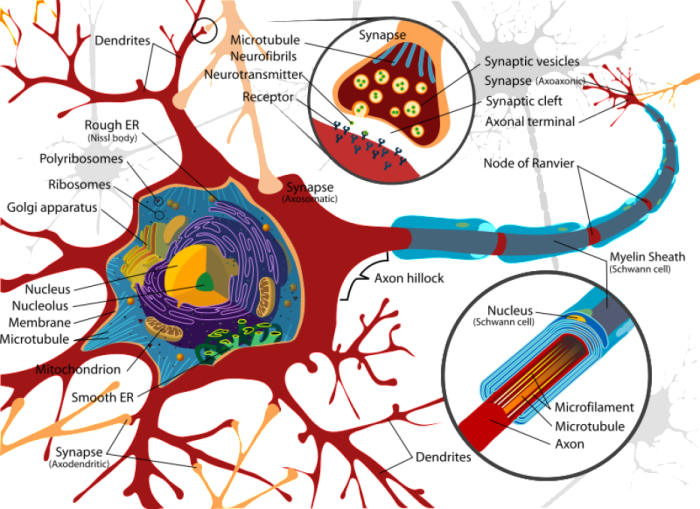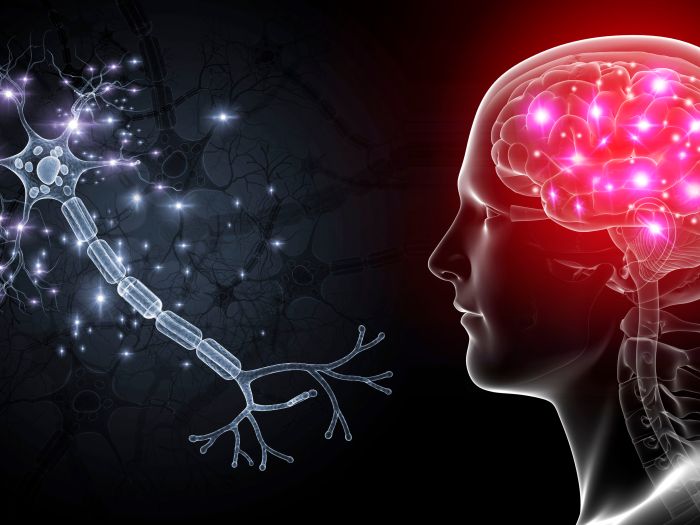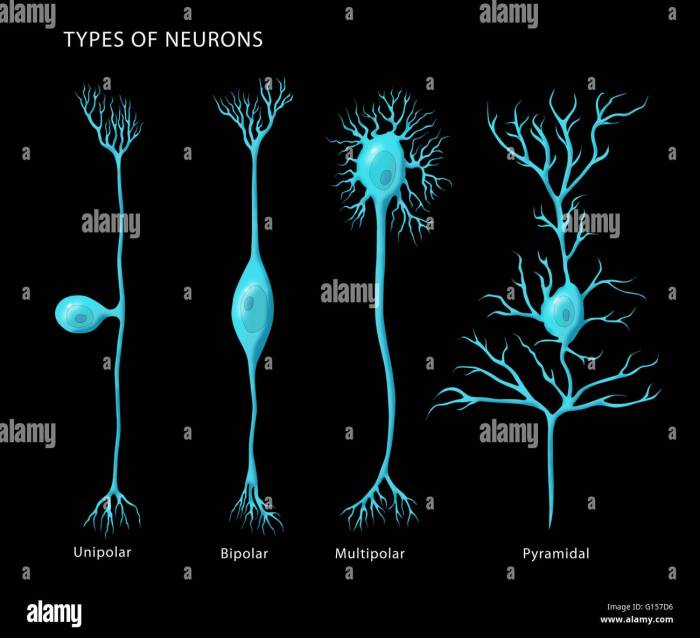As the enigma of “how many neurons in human brain” takes center stage, this discourse unveils the complexities of the human brain, its vast network of neurons, and their profound impact on our existence.
Delving into the intricacies of this topic, we explore the methodologies employed to estimate neuron count, examining their strengths and limitations. From historical approximations to contemporary advancements, we unravel the range of estimates and delve into the factors contributing to their variations.
Introduction
The human brain is a complex organ, composed of an intricate network of neurons. These specialized cells are the fundamental building blocks of the brain, responsible for transmitting information and enabling all cognitive functions.
Neurons play a vital role in everything we do, from simple reflexes to complex thought processes. They receive, process, and transmit electrical and chemical signals, allowing us to interact with our environment, learn, remember, and make decisions.
Functions of Neurons
Neurons have three main components: the cell body, dendrites, and axon. The cell body contains the nucleus and other organelles essential for the neuron’s function. Dendrites are short, branching extensions that receive signals from other neurons. The axon is a long, slender extension that transmits signals away from the cell body to other neurons or muscles.
When a neuron receives a strong enough signal, it generates an electrical impulse called an action potential. This impulse travels down the axon and triggers the release of neurotransmitters, chemical messengers that transmit the signal to other neurons.
Methods for Estimating Neuron Count

Determining the exact number of neurons in the human brain remains a complex challenge, but scientists have developed various techniques to provide estimates. These methods include stereology and magnetic resonance imaging (MRI), each with its own strengths and limitations.
Stereology
Stereology is a quantitative microscopy technique used to estimate the number of neurons in a specific brain region. It involves taking a series of thin tissue sections and analyzing them under a microscope. The number of neurons in each section is counted, and the total number is estimated based on the volume of the brain region and the thickness of the sections.
Strengths:
- Accurate for small brain regions
- Provides detailed information about neuron distribution
Limitations:
- Time-consuming and labor-intensive
- Not suitable for estimating neuron count in the entire brain
Magnetic Resonance Imaging (MRI)
MRI is a non-invasive imaging technique that uses magnetic fields and radio waves to create detailed images of the brain. By analyzing the MRI scans, researchers can estimate the number of neurons based on the volume of the brain regions and the signal intensity of the neurons.
Strengths:
- Non-invasive and widely available
- Can provide estimates for the entire brain
Limitations:
- Less accurate than stereology
- Can be affected by factors such as age and brain disorders
Estimates of Neuron Count

Determining the precise number of neurons in the human brain remains a challenging task, with estimates varying widely over time. Factors contributing to these variations include advancements in technology, research methods, and the complexity of the brain itself.
Historical Estimates
Early estimates of neuron count in the human brain were made in the 19th century. German anatomist Franz Nissl proposed a figure of 9.2 billion neurons, while his contemporary Santiago Ramón y Cajal suggested a much higher number of 14 billion.
Contemporary Estimates
With the advent of more sophisticated techniques like stereology and magnetic resonance imaging (MRI), contemporary estimates have refined our understanding of neuron count. A study published in 2012 estimated the number of neurons in the cerebral cortex alone to be around 16 billion, with the total number in the entire brain likely exceeding 86 billion.
Factors Contributing to Variations
- Methodological Differences:Different research methods, such as stereology and MRI, yield varying results due to their inherent limitations and assumptions.
- Regional Variability:The number of neurons varies across different brain regions, with the cerebral cortex containing a significantly higher density than other areas.
- Individual Differences:There is evidence to suggest that the number of neurons can vary between individuals, potentially due to genetic factors or environmental influences.
Distribution of Neurons
The distribution of neurons in the human brain is not uniform. Some areas have a much higher density of neurons than others. The cerebral cortex, which is responsible for higher-order functions such as thinking, planning, and language, has the highest density of neurons.
The cerebellum, which is responsible for motor coordination, has a lower density of neurons. The brainstem, which is responsible for basic functions such as breathing and heart rate, has the lowest density of neurons.
The distribution of neurons in the brain is related to brain function. The areas with the highest density of neurons are responsible for the most complex functions. The areas with the lowest density of neurons are responsible for the most basic functions.
Regional Distribution of Neurons
The regional distribution of neurons in the human brain can be divided into three main areas: the cerebral cortex, the cerebellum, and the brainstem.
- Cerebral Cortex:The cerebral cortex is the largest part of the brain and is responsible for higher-order functions such as thinking, planning, and language. It has the highest density of neurons in the brain.
- Cerebellum:The cerebellum is located at the back of the brain and is responsible for motor coordination. It has a lower density of neurons than the cerebral cortex.
- Brainstem:The brainstem is located at the base of the brain and is responsible for basic functions such as breathing and heart rate. It has the lowest density of neurons in the brain.
Comparison to Other Species: How Many Neurons In Human Brain

The human brain contains an astonishing number of neurons, far outnumbering that of other species. This remarkable difference has significant implications for our understanding of brain evolution and cognition.
In general, the number of neurons in the brain correlates with the size and complexity of the organism. Larger animals tend to have more neurons than smaller ones, and mammals typically have more neurons than non-mammals. However, the human brain stands out as an exception to this trend.
Mammals, How many neurons in human brain
Compared to other mammals, the human brain has a disproportionately large number of neurons. For instance, the average human brain contains around 86 billion neurons, while the brain of a chimpanzee, our closest living relative, has only about 35 billion neurons.
This difference is even more pronounced when compared to smaller mammals such as mice, which have only about 75 million neurons.
Non-Mammals
The disparity between the human brain and that of non-mammals is even greater. Birds, for example, have brains that contain only a few billion neurons, while reptiles and amphibians have even fewer. This difference in neuron count reflects the different cognitive abilities of these animals.
Humans possess a far more complex repertoire of behaviors and cognitive skills than other species, and this is likely due in part to the vast number of neurons in our brains.
Implications
The high neuron count in the human brain has profound implications for our understanding of brain evolution and cognition. It suggests that the human brain has undergone a significant expansion in size and complexity over time, allowing for the development of advanced cognitive abilities such as language, abstract reasoning, and self-awareness.
Factors Influencing Neuron Count
The number of neurons in the human brain is not fixed but can vary depending on several factors. These factors include genetics, environment, and experience.Genetics plays a role in determining the number of neurons a person is born with. However, the environment and experience can also influence the number of neurons that are present in the brain.
For example, research has shown that people who grow up in enriched environments have more neurons in certain brain regions than those who grow up in impoverished environments. Similarly, people who engage in mentally stimulating activities, such as learning new things or playing games, have more neurons in certain brain regions than those who do not.The interaction of these factors helps shape brain development and function.
For example, a person who is born with a high number of neurons in a particular brain region may be more likely to excel in activities that require that brain region. Similarly, a person who grows up in an enriched environment and engages in mentally stimulating activities may be more likely to have a larger number of neurons in certain brain regions, which may give them an advantage in certain cognitive tasks.
Genetics
The genes that a person inherits from their parents can influence the number of neurons they have in their brain. Some genes are involved in the production of neurons, while others are involved in the survival and maintenance of neurons.
Variations in these genes can lead to differences in the number of neurons in the brain.
Environment
The environment in which a person grows up can also influence the number of neurons they have in their brain. For example, people who grow up in enriched environments, such as those with access to good nutrition, education, and social support, have more neurons in certain brain regions than those who grow up in impoverished environments.
Experience
The experiences that a person has throughout their life can also influence the number of neurons they have in their brain. For example, people who engage in mentally stimulating activities, such as learning new things or playing games, have more neurons in certain brain regions than those who do not.
Significance of Neuron Count
The number of neurons in the human brain has a profound impact on our cognitive abilities and overall brain function. Variations in neuron count can contribute to individual differences in intelligence, memory, and susceptibility to neurological disorders.
Implications for Brain Function and Behavior
The number of neurons in the brain influences the complexity and efficiency of neural circuits. A higher neuron count allows for more complex and interconnected networks, which in turn supports higher cognitive functions such as reasoning, problem-solving, and decision-making. Additionally, the density of neurons in specific brain regions is associated with specialized functions, such as language processing in Broca’s area or facial recognition in the fusiform face area.
Individual Differences and Neurological Disorders
Individual differences in neuron count may contribute to variations in cognitive abilities. For instance, studies have shown a correlation between higher neuron density in the prefrontal cortex and better performance on working memory tasks. Conversely, reduced neuron count in certain brain regions has been linked to an increased risk of developing neurological disorders such as Alzheimer’s disease, schizophrenia, and autism spectrum disorder.
Closing Notes
In conclusion, the quest to determine “how many neurons in human brain” has led us on an enlightening journey through the intricate tapestry of the human mind. While estimates vary, the sheer magnitude of neurons underscores the brain’s remarkable capacity for processing, learning, and shaping our experiences.
FAQ Corner
How do scientists estimate the number of neurons in the human brain?
Researchers utilize various techniques, including stereology and magnetic resonance imaging (MRI), to provide approximations of neuron count.
What factors can influence the number of neurons in the human brain?
Genetics, environment, and experiences play a role in shaping the development and function of the brain, including the number of neurons.
How does the distribution of neurons relate to brain function?
The regional distribution of neurons corresponds to specific functions, with areas of high neuron density often associated with complex cognitive processes.